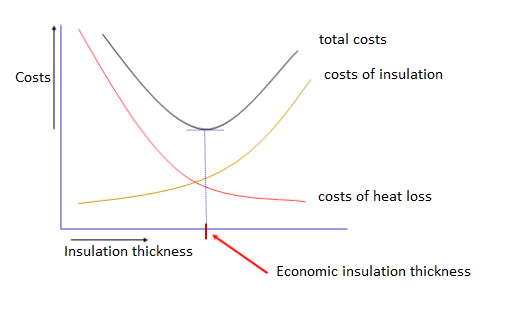Heat insulation
The thickness of thermal insulation can be determined based on two different requirements. One is the economic insulation thickness, the other is the personal protection (sheeting temperature). The basic calculations are defined in ISO 12241. Below the economic insulation thickness will be explained briefly.
Economic insulation thickness
The thickness of an insulation system is determined by the most optimal cost structure, with the lowest total annual costs. The three main cost components in this cost structure are:
• The cost of the insulation system proper i.e. capital cost
• The cost of the maintenance of the installed insulation system
• The cost of the energy lost through the insulation system
The total costs for a specific thickness of insulation are the sum of the above listed costs, at similar conditions. Thereto, the costs of the insulation system have to be determined per annum on the basis of the investment cost multiplied by an escalation factor, in combination with the costs of maintenance. These annual costs are set off against the annual cost of energy loss.
The optimal economic insulation thickness can be calculated with the formula for the ‘minimum total cost method’:
Minimum total cost method
Total annual costs = (investment x escalation factor + maintenance) + operating costs (energy loss).
The economic insulation thickness is the thickness which is corresponding with the lowest point on the total cost curve (y-axis). See graph.
In industry, preference is given to the minimum total cost method. This method is particularly suitable if the insulation systems is expected to consist of more than one layer. The results can be displayed in a graph so that the lowest costs are visible immediately.


